Family : Labridae

Text © Giuseppe Mazza

English translation by Mario Beltramini
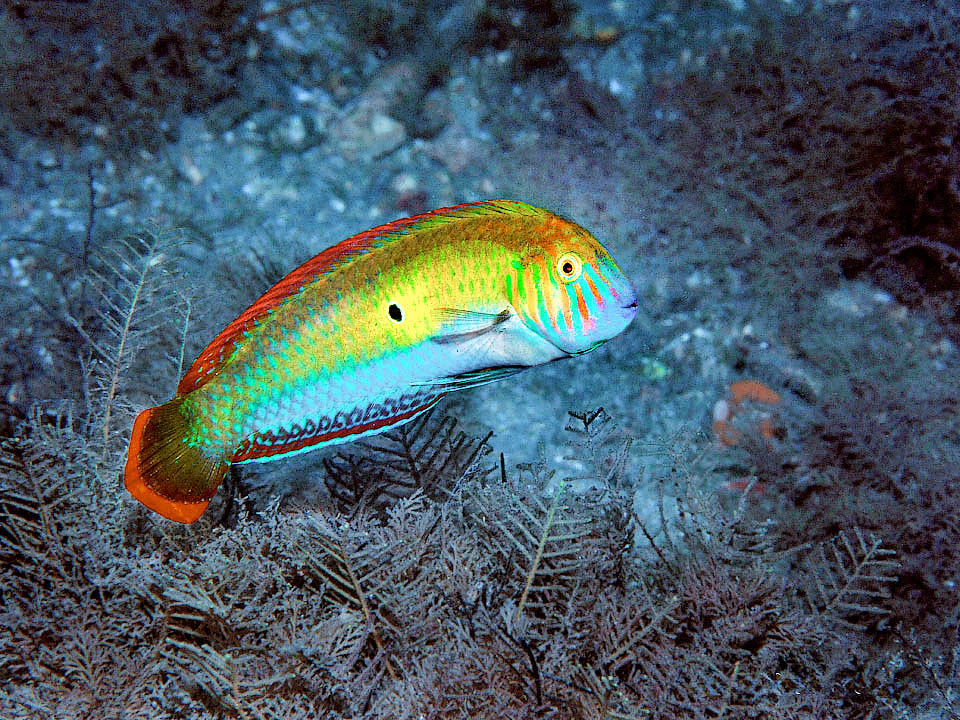
The Green razorfish (Xyrichtys splendens) lives along the western Atlantic coasts, from Bermuda and south Florida to Brazil © Pauline Walsh Jacobson
Xyrichtys splendens Castelnau,1855, known as Green razorfish, belongs to the class of the Actinopterygii, the ray-finned fish, to the order of the Perciformes and to the family of the Labridae, present on almost all seas with about 70 genera, 600 species and often bright liveries, changeable depending on the circumstances and on the age.
They can change instantly colour acting on the chromatophores, the cells of the skin containing the pigments, and go through three phases of growth: the youth phase, the initial and the terminal ones with protogynous hermaphroditic females that change appearance becoming male.
The genus Xyrichtys, from the Greek “xyron”, razor and “ichthys”, fish, refers as its common name to the thin look of the body, similar to a blade, that allows them to disappear in an instant under the sand to escape predators, whilst the specific term splendens underlines in Latin the beauty of its splendid and bright livery.
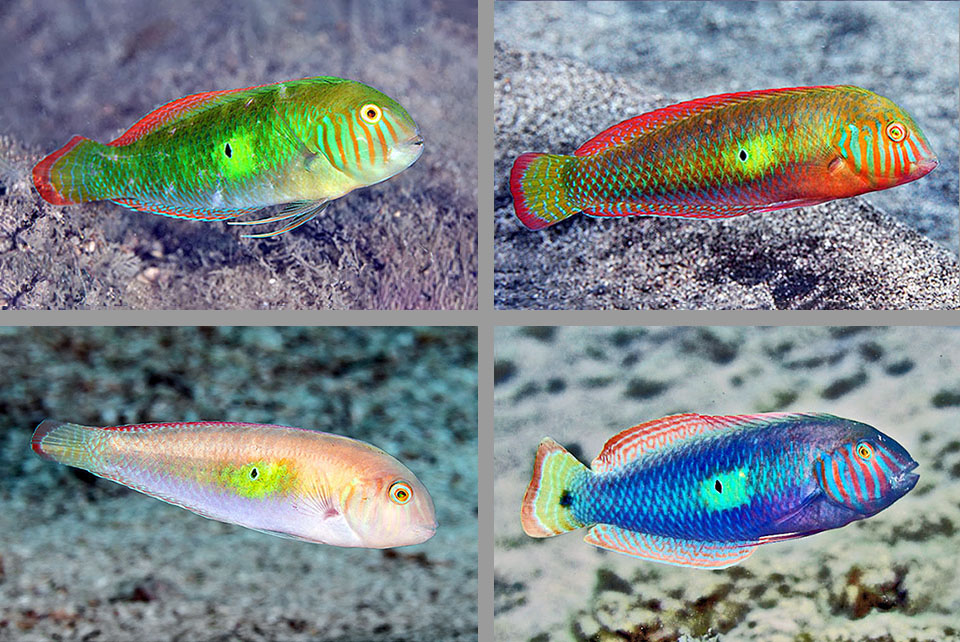
It’s a species with three growth phases and great colours variability due to chromatophores. Here some images of Terminal Phase, the males’, easy to recognize at first sight due to the clear zone with black spot on the centre of the sides © Frank Krasovec (picture up left) © www.carlosestape.photoshelter.com (the others pictures)
Zoogeography
Xyrichtys splendens is frequent along the coasts of western Atlantic, from the Bermudas and southern Florida up to Brazil, that at times shares with Xyrichtys novacula also present in the Mediterranean and in eastern Atlantic.
Ecology-Habitat
The Green razorfish loves the temperatures included between 26,3 and 28,2 °C and is usually found between 3 and 15 m of depth, insandy zones among rocks and madreporic formartions, but also in the submerged prairies of phanerogams where it finds food and shelter protected by its mimetic livery.

Instead this the Initial Phase, with hermaphroditic protogynous females that growing may turn in males © Frank Krasovec
Where these environments are absent it does not discourage and often creates an artificial sandy environment in the vicinity, a cozy groove, about ten centimetres wide, target of repeated dives that end up transforming even the slightly friable soils in a soft shelter.
Morphology
Xyrichtys splendens can reach the length of 17,5 cm but rarely exceeds 15.
The head, oblong and compressed like the body, has the snout with blunt tip and a fleshy longitudinal keel continues on the forehead facilitating the penetration into the seabeds.
The small eyes are placed high up and the mouth, protractile, has thick lips.
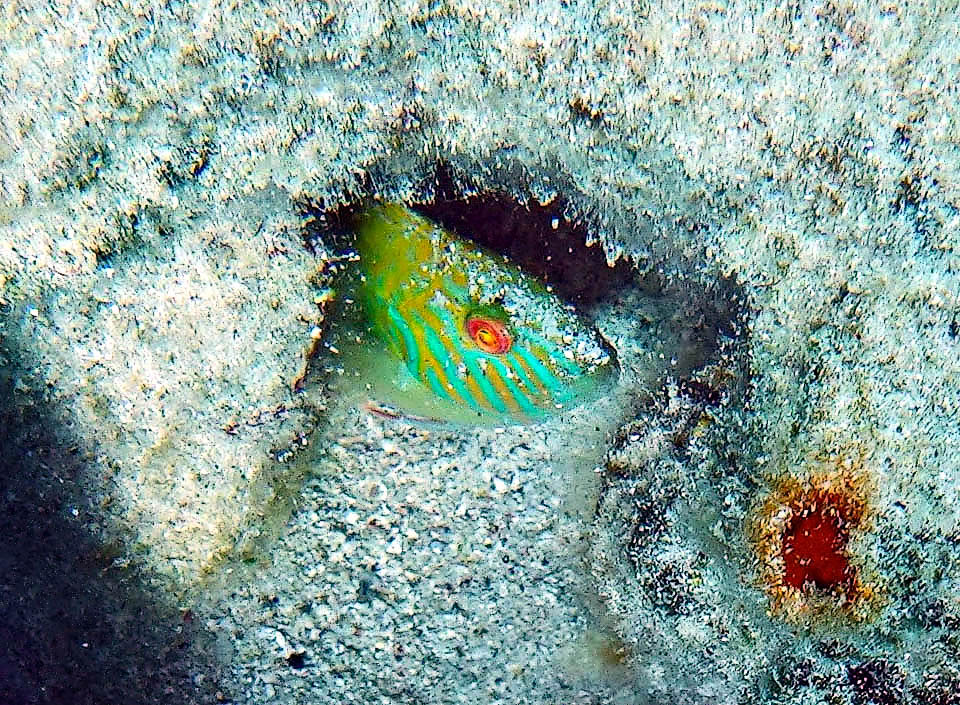
In case of danger Xyrichtys splendens enters the sand and disappears from predators’ sight, and if seabed is hard it softens with repeated dips a small nearby shelter © Sue
Both jaws have on the front a pair of big canines. No others are present in the mouth, but we note dental crushing plaques on the throat.
The dorsal fin has 9 spiny rays and 12 unarmed; the anal 3 hard rays and 13 soft; the pelvic onses, sharp, end with a long filament in the adults; the pectoral ones have 2 normal rays and 10 ramified; and the caudal fin is rounded.
There are no scales on the cheek, the operculum, the lower jaw and the base of the dorsal or the anal fins.
The juveniles, with various liveries where the yellow, green or black colour predominates, have the first two rays of the dorsal conspicuously stretched out and usually have 3 vertical brown bars on the body continuing also on the dorsal and anal fins.
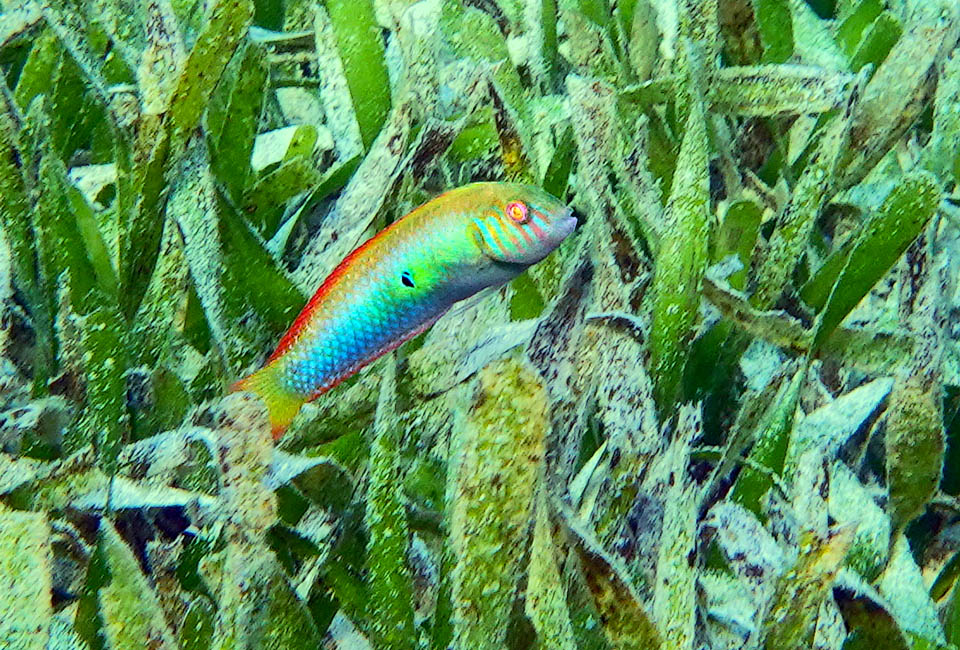
It may also hide among the leaves of the phanerogams submerged prairies where it finds small prey and its mimetic livery very often goes unnoticed © Sue
The Initial Phase, the female one, presents pinkish bands and scales with black outline.
The Final Phase is that of the males, with the steepest head profile and a very variable livery with green dominants, as states the vulgar name, but also blue, red or pinkish. There is always a characteristic clear zone on the centre of the sides with one or two black spots circled in blue. The cheeks are crossed by thin orange bars and every scale has a vertical small spot. The dorsal fin is reddish, and the anal displays blue arabesques followed by one red band as well as towards the caudal extremity.
This is the elegant and unmistakable command livery, because the males have a territory and a small harem.
Ethology-Reproductive Biology
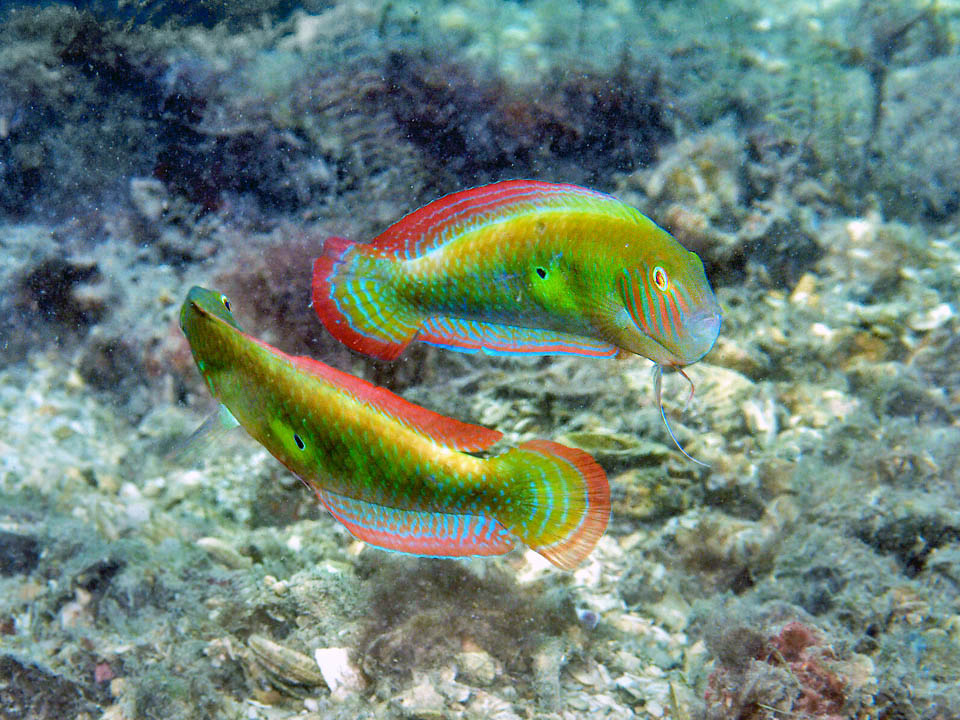
A males dispute. These have a harem and territory where they allow only females to enter. The reproduction occurs by evening on surface with the partner on duty © Pauline Walsh Jacobson
Xyrichtys splendens feeds only on shrimp, amphipods and plankton copepods but also on small fishes, gastropods, and bivalves like the clams.
Reproduction takes place in pairs, with male raising to the surface in the evening with the chosen partner on duty for fecundating the eggs entrusted to the currents.
Also the larvae are planktonic and the resilience of the species is excellent,with possible doubling of the populations in less than 15 months.
The Green razorfish is preyed upon by barracudas, groupers, tuna and snappers. Sometimes caught for the aquaria, it has however a very low fishing vulnerability marking only 10 on a scale of 100.

Chromatic variabilities in Juvenile Phase, characterized by the first two rays of the dorsal fin conspicuously elongated and often 3 dark vertical bars © www.carlosestape.photoshelter.com
The populations are stable and from 2009 Xyrichtys splendens appears consequently as “LC, Least Concern”, in the IUCN Red List of the endangered species.
Synonyms
Xyrichthys splendens Castelnau, 1855; Hemipteronotus splendens (Castelnau, 1855); Xyrichtys ventralis Bean, 1891; Hemipteronotus ventralis (Bean, 1891).
→ For general information about FISH please click here.
→ For general information about BONY FISH please click here
→ For general information about CARTILAGINOUS FISH please click here.
→ To appreciate the BIODIVERSITY of BONY FISH please click here.
→ To appreciate the BIODIVERSITY of CARTILAGINOUS FISH please click here.
